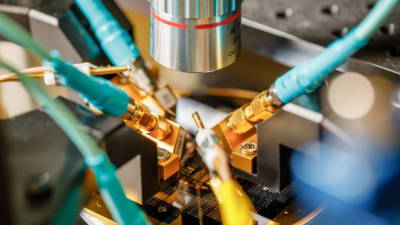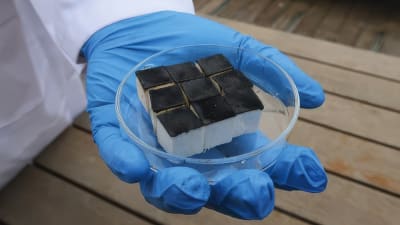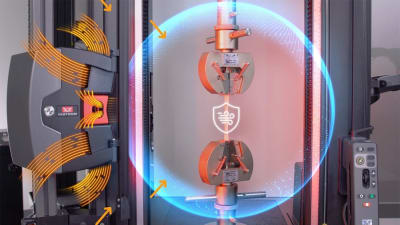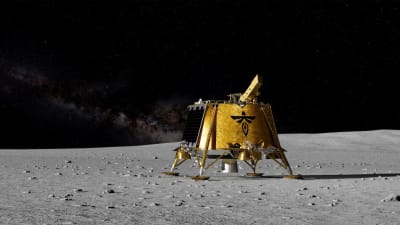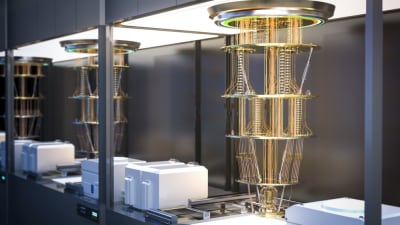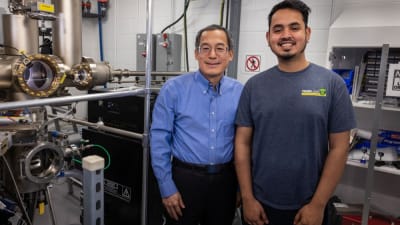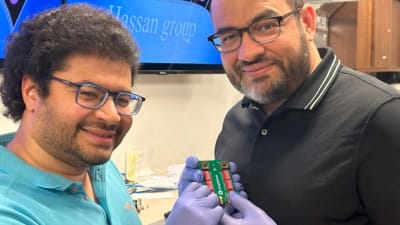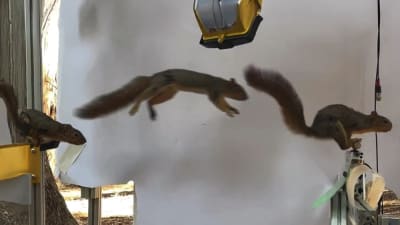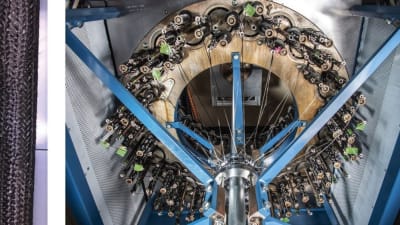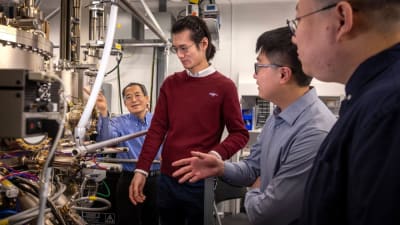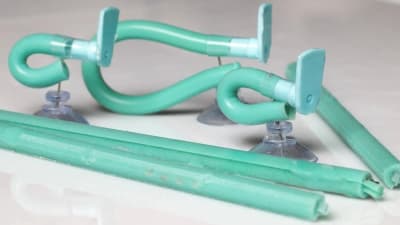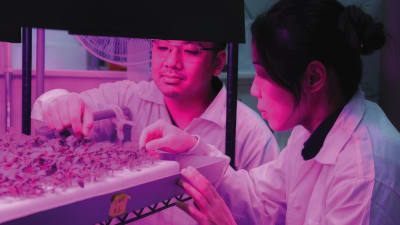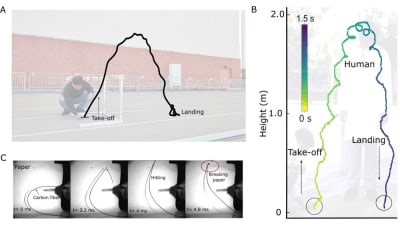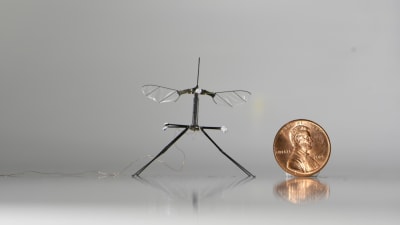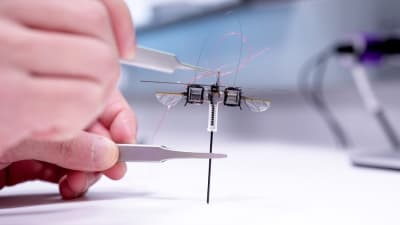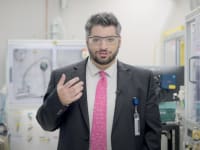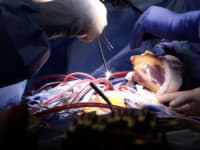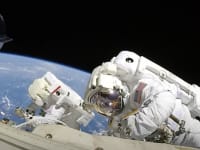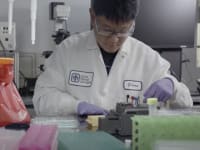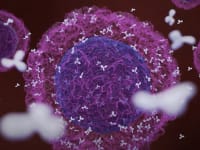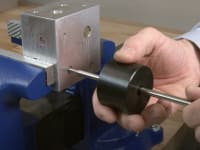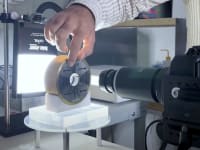Stories
6
61
-1
30
30
INSIDER: Sensors/Data Acquisition
As electronics become smaller, it is becoming increasingly difficult to continue scaling down silicon-based transistors. Now, a research team led by the Institute of Industrial...
INSIDER: Communications
A new class of synthetic materials could herald the next revolution of wireless technologies, enabling devices to be smaller, require less signal strength and use less power.
Briefs: Materials
Using a new technology, Juan-Pablo Correa-Baena's lab has found a way to stabilize perovskite solar cells, which are built like a battery. Read on to learn more.
Briefs: Green Design & Manufacturing
Engineers from Australia and China have invented a sponge-like device that captures water from thin air and then releases it in a cup using the sun’s energy, even in low humidity where other technologies such as fog harvesting and radiative cooling have struggled. Read on to learn more.
Products: Robotics, Automation & Control
See what's new on the market, including a solution for actuating choke and other valves in subsea applications; Sumida's new CEP1311F Flyback Transformers, designed for use with “no-opto” isolated flyback circuits; SPIROL's range of 2024 aluminum Press-In Inserts; Instron's AVE3, an advanced non-contacting video extensometer that delivers precise strain measurement with unparalleled, micron-level accuracy; and more.
INSIDER: Manufacturing & Prototyping
Researchers have created dynamic structures that leap into the air on a predetermined schedule without intervention from computers or external stimuli. Precisely when these...
Blog: Design
The new robot, dubbed ATMO (aerially transforming morphobot), uses four thrusters to fly, but the shrouds that protect them become the system's wheels in an alternative driving configuration. The whole transformation relies on a single motor to move a central joint that lifts ATMO's thrusters up into drone mode or down into drive mode.
Articles: Physical Sciences
In this interview, Joseph Marlin, Deputy Blue Ghost Chief Engineer at Firefly Aerospace, delves deeper into how their first mission is establishing an improved awareness of the lunar environment ahead of future crewed missions and how it will help plan for long-duration surface operations under Artemis.
Blog: Sensors/Data Acquisition
My Opinion: Quantum computing is coming but has this engineer puzzled. As we celebrate 2025, the International Year of Quantum Science and Technology, I find that thinking about these things from an engineer’s point of view is quite challenging.
INSIDER: Robotics, Automation & Control
A spherical prototype that can change its surface from smooth to dimpled, cuts through drag and generates lift. Underwater or aerial vehicles with dimples like golf balls...
INSIDER: Manufacturing & Prototyping
As the growth in global electricity need and supply continues to accelerate, efficient power electronics will be key to improving grid efficiency, stability, integration, and resilience for...
INSIDER: Design
Superconductivity is an advantageous property observed in some materials. It entails an electrical resistance of zero at extremely low temperatures....
INSIDER: Physical Sciences
Improving energy conversion efficiency in power electronics is vital for a sustainable society, with wide-bandgap semiconductors like GaN and SiC power devices offering...
Blog: Robotics, Automation & Control
The work shows how a soft robot can use suction flow not just to stick to things, but also to sense its environment and control its own actions — just like an octopus.
INSIDER: Physical Sciences
Stronger cell phone signals, more accurate sensors, and cleaner energy may be achieved by adding a simple step to the industrial fabrication process of...
INSIDER: Sensors/Data Acquisition
Northwestern University researchers have developed the first wearable device for measuring gases emitted from and absorbed by the skin. By analyzing these gases, the device...
INSIDER: Electronics & Computers
What if ultrafast pulses of light could operate computers at speeds a million times faster than today's best processors? A team of scientists, including researchers from...
Briefs: Robotics, Automation & Control
University of California Berkeley biologists and engineers have designed a hopping robot that can stick a landing on a narrow perch. The feat is a big step in the design of more agile robots, ones that can leap among the trusses and girders of buildings under construction or robots that can monitor the environment in tangled forests or tree canopies. Read on to learn more.
Briefs: Physical Sciences
Innovators at the NASA Glenn Research Center have developed a toughened hybrid reinforcement material made from carbon fiber and carbon nanotube (CNT) yarn for use in polymer matrix composites (PMCs). The new material improves toughness and damping properties of PMCs, enhancing impact resistance, fatigue life, as well as structural longevity. Read on to learn more.
INSIDER: Electronics & Computers
The mechanism holding new ferroelectric semiconductors together produces a conductive pathway that could enable high power transistors. A new class of...
Blog: Robotics, Automation & Control
Inspired by the movements of a tiny parasitic worm, Georgia Tech engineers have created a five-inch soft robot that can jump as high as a basketball hoop.
White Papers: Physical Sciences
Lightweight, Non-Magnetic UHV Suitcases Feature Atlas Technologies Aluminum Vacuum Chambers and Titanium/Aluminum Bimetal Flanges
Atlas Technologies’ customer, VolkVac Instruments, needed a UHV chamber small enough and light enough to easily...Application Briefs: Lighting
Exploiting the “spatial” degree of freedom of light can mean many things. Read on to learn what they are and what the process can lead to.
Briefs: Physical Sciences
Residents of the Manu’a Islands in American Samoa were feeling the earth shake, raising concerns of an imminent volcanic eruption or tsunami. Scientists from the U.S. Geological Survey used machine learning and a technique called template matching on shaking data recorded from a single seismic sensor located 250 kilometers away to locate the source of the shaking. Read on to learn more.
Briefs: Materials
Researchers have developed a groundbreaking near-infrared fluorescent nanosensor capable of simultaneously detecting and differentiating between iron forms — Fe(II) and Fe(III) — in living plants. Read on to learn more about it.
Briefs: Semiconductors & ICs
A joint research effort led by the University of Illinois Urbana-Champaign has shown how coal can play a vital role in next-generation electronic devices. Read on to learn more about it.
INSIDER: Robotics, Automation & Control
Inspired by the movements of a tiny parasitic worm, Georgia Tech engineers have created a 5-inch soft robot that can jump as high as a basketball hoop. Their device, a silicone...
INSIDER: Unmanned Systems
The Harvard RoboBee has long shown it can fly, dive, and hover like a real insect. But what good is the miracle of flight without a safe way to land? A storied engineering achievement by the Harvard...
Blog: Physical Sciences
The hopping robot, which is smaller than a human thumb and weighs less than a paperclip, has a springy leg that propels it off the ground and four flapping-wing modules that give it lift and control its orientation.
Top Stories
Blog: Manufacturing & Prototyping
2025 Holiday Gift Guide for Engineers: Tech, Tools, and Gadgets
INSIDER: Research Lab
Scientists Create Superconducting Semiconductor Material
Blog: Software
Quiz: Materials
Blog: Aerospace
Tech Briefs Wrapped 2025: Top 10 Technology Stories
Blog: Manufacturing & Prototyping
Webcasts
 Upcoming Webinars: AR/AI
Upcoming Webinars: AR/AI
The Real Impact of AR and AI in the Industrial Equipment Industry
 Upcoming Webinars: Motion Control
Upcoming Webinars: Motion Control
Next-Generation Linear and Rotary Stages: When Ultra Precision...
 Upcoming Webinars: Energy
Upcoming Webinars: Energy
Hydrogen Engines Are Heating Up for Heavy Duty
 Podcasts: Medical
Podcasts: Medical
How Wearables Are Enhancing Smart Drug Delivery
 Podcasts: Power
Podcasts: Power
SAE Automotive Podcast: Solid-State Batteries



